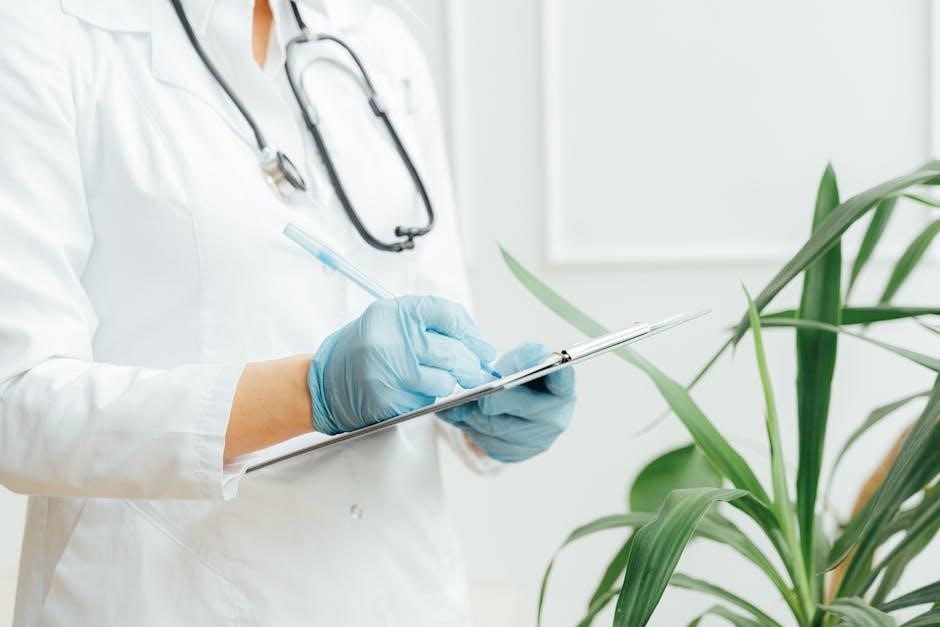Phlebotomy involves collecting blood samples for laboratory testing, playing a crucial role in healthcare diagnostics. It requires precision and care to ensure patient safety and accurate results.
1.1 Definition and Overview
Phlebotomy refers to the process of making an incision in a vein with a needle to collect blood samples for laboratory analysis. Derived from the Greek words “phlebos” (vein) and “tome” (to cut), it is a vital procedure in healthcare diagnostics. Phlebotomists perform this task, ensuring proper techniques to maintain patient safety and sample integrity; The process involves collecting blood through venipuncture or capillary sampling, using appropriate equipment like needles, syringes, and evacuated tubes. Accurate blood collection is essential for reliable test results, making phlebotomy a cornerstone of medical testing.
1.2 Historical Background
Phlebotomy traces its roots to ancient civilizations, where bloodletting was practiced for therapeutic purposes. Early methods involved crude tools, with little emphasis on safety or hygiene. The Greeks and Romans used venesection to balance “humors,” while medieval practitioners continued such techniques. The 19th century saw advancements in understanding blood composition, leading to more precise collection methods. Modern phlebotomy evolved in the 20th century, incorporating sterile techniques and specialized equipment, transforming it into a critical diagnostic tool in healthcare, ensuring patient safety and accurate test results.
1.3 Role of Phlebotomists in Healthcare
Phlebotomists play a vital role in healthcare by collecting blood samples essential for diagnostic testing. Their expertise ensures accurate and safe specimen collection, maintaining patient trust and comfort. Proper techniques, attention to detail, and adherence to safety protocols are critical in their daily tasks. Phlebotomists also contribute to efficient laboratory workflows, enabling timely medical decisions. Their role extends beyond technical skills, as they often provide reassurance to anxious patients, making them integral to the healthcare team and the diagnostic process.

Methods of Blood Collection
Common methods include venipuncture and skin puncture. Venipuncture uses needles for blood collection, while skin puncture involves capillary sampling for small amounts. Both ensure safety and efficiency.
2.1 Venipuncture
Venipuncture is the most common method of blood collection, involving the insertion of a needle into a vein. It requires skill and precision to ensure patient comfort and safety. Proper technique involves anchoring the vein, using the correct needle bevel orientation, and collecting blood into evacuated tubes. This method is preferred for obtaining larger blood samples needed for comprehensive laboratory testing. Correct site selection and preparation are essential to minimize complications and ensure accurate results. Venipuncture is a cornerstone in phlebotomy practice.
2.2 Skin Puncture (Capillary Sampling)
Skin puncture, or capillary sampling, involves obtaining blood from small, superficial blood vessels using a lancet or needle. This method is commonly used for glucose testing, bilirubin levels in newborns, and other point-of-care tests. The procedure typically involves cleaning the site, pricking the skin, and collecting the blood on a test strip or into a small tube. Capillary sampling is less invasive than venipuncture and is often used for patients with difficult venous access, such as infants or elderly individuals. Proper technique is crucial to ensure accurate results and minimize discomfort.

Safety Protocols
Safety protocols in phlebotomy include handling biohazardous materials, proper use of PPE, and safe disposal of needles to prevent exposure to bloodborne pathogens and maintain a sterile environment.
3.1 Handling Biohazardous Materials
Handling biohazardous materials in phlebotomy requires strict adherence to safety protocols to prevent exposure to bloodborne pathogens. This includes proper disposal of needles, using safety devices to minimize needlestick injuries, and ensuring all blood samples are stored in leak-proof containers. Gloves and lab coats should always be worn, and surfaces should be disinfected regularly. Spills must be cleaned immediately with appropriate cleaning solutions. These measures are critical to protecting both healthcare workers and patients from potential infections and maintaining a safe working environment.
3.2 Proper Use of Personal Protective Equipment (PPE)
Proper use of PPE is essential in phlebotomy to minimize exposure to bloodborne pathogens. Gloves should be worn at all times when handling blood or sharps, and lab coats or gowns must be used to protect clothing. Face masks and eye protection are required when there is a risk of blood splashing. PPE should be put on before starting procedures and removed immediately after, following proper disposal protocols. This ensures a safe environment for both patients and healthcare workers, preventing potential infections and maintaining hygiene standards.

Essential Equipment and Supplies
Key equipment includes needles, syringes, evacuated blood collection tubes, tourniquets, and phlebotomy chairs; These tools ensure efficient and safe blood collection, while supplies like gauze and gloves maintain patient comfort and hygiene.
4.1 Needles and Syringes
Needles and syringes are critical tools in phlebotomy, used for venipuncture and blood collection. Needles typically range from 21 to 25 gauge, with beveled edges to ensure smooth entry into veins. Syringes are often pre-attached to needles or used in conjunction with blood collection systems. The choice of needle size and type depends on the patient’s vein size and the procedure’s requirements.
Butterfly needles are commonly used for difficult venipuncture, while standard needles are preferred for routine blood draws. Safety needles with protective mechanisms are recommended to prevent accidental needlestick injuries. Syringes may vary in size based on the volume of blood needed for testing, ensuring accurate sample collection and patient comfort.
4.2 Evacuated Blood Collection Tubes
Evacuated blood collection tubes are sterile, pre-sealed containers used with needles to collect blood samples. They contain additives like anticoagulants or clot activators to preserve samples for specific tests. The vacuum inside ensures a precise blood volume is drawn, minimizing errors. Tubes are color-coded for easy identification, and their use streamlines the collection process. Proper selection and order of draw are crucial to avoid cross-contamination and ensure accurate test results. Safety features like needle guards enhance protection during procedures.
4.3 Tourniquets and Phlebotomy Chairs
Tourniquets are used to restrict blood flow to a limb, aiding in vein visualization and easier access during blood collection. They are applied between the shoulder and elbow for arm veins. Phlebotomy chairs are designed to position patients comfortably, ensuring proper posture and vein accessibility. These tools enhance the efficiency and safety of blood collection procedures, reducing patient discomfort and improving outcomes. Proper use of tourniquets and chairs is essential for effective phlebotomy practices.

Patient Identification and Preparation
Patient identification ensures correct sample collection, while preparation involves explaining procedures, positioning, and addressing anxieties to ensure a smooth blood draw experience.
5.1 Importance of Correct Patient Identification
Correct patient identification is critical to ensure accurate test results and prevent medical errors. Using two patient identifiers, such as name and date of birth, confirms the right patient. This step is essential for safety, reducing mix-ups and legal risks. Proper identification fosters trust and ensures that blood samples are correctly matched to patients. It is a foundational step in phlebotomy, minimizing errors and ensuring reliable outcomes.
5.2 Preparing the Patient for Blood Draw
Preparing the patient involves ensuring their comfort and readiness for the procedure. Clean and disinfect the area, and position the patient appropriately, either seated or lying down. Apply a tourniquet to visualize veins and explain the process to ease anxiety. Ensure the patient’s arm is straight and supported. Avoid using arms with medical devices or injuries. Check for any allergies or fainting history. Ensure the patient is relaxed to facilitate smooth blood collection and minimize complications.
Site Selection and Preparation
Selecting the appropriate venipuncture site is crucial for a successful blood draw. Common sites include the median cubital vein in the antecubital fossa. Ensure the area is clean, dry, and free from obstruction for optimal access and patient comfort.
6.1 Common Venipuncture Sites
The most common venipuncture sites include the median cubital vein in the antecubital fossa, cephalic vein in the forearm, basilic vein, and brachial vein. These sites are chosen for their accessibility and visibility. The median cubital vein is the preferred site due to its superficial location and ease of access. Other sites, such as the dorsal hand veins, may be used when the standard sites are difficult to access. Proper site selection ensures a successful and comfortable blood draw for the patient.
- Median cubital vein
- Cephalic vein
- Basilic vein
- Brachial vein
6.2 Skin Preparation Techniques
Proper skin preparation is essential to ensure a clean and successful venipuncture. The site should be cleaned with an antiseptic solution, such as alcohol or iodine, to remove bacteria and contaminants. Allow the area to air dry completely to prevent any residual moisture. Avoid touching the prepared site to maintain sterility. These steps minimize the risk of infection and contamination, ensuring accurate laboratory results. Proper preparation also helps in achieving a clear venipuncture site for easy access.
- Clean the site with antiseptic solution
- Allow the area to air dry
- Avoid touching the prepared site

Order of Draw
Order of draw refers to the sequence of collecting blood samples into different tubes to prevent cross-contamination of additives, ensuring accurate test results and patient safety.
7.1 Standard Order of Drawing Blood Samples
The standard order of drawing blood samples is crucial for accurate test results. Start with blood culture bottles to avoid contamination, followed by coagulation tubes. Next, draw serum separator tubes (SST) and heparin or EDTA tubes for plasma determinations. Finally, collect tubes with other additives. This sequence prevents cross-contamination of additives, ensuring reliable laboratory outcomes and maintaining patient safety. Adhering to this order is essential for phlebotomists to deliver high-quality blood samples for diagnostic purposes.
7.2 Special Considerations in Order of Draw
Special considerations in the order of draw include exceptions for specific patient conditions or unique tube requirements. For example, light-blue tubes for coagulation must be drawn first to prevent contamination from other additives. Additionally, certain tests may require tubes to be drawn in a specific sequence, such as blood culture bottles before other tubes. In some cases, the order may need to be adjusted based on the patient’s diagnosis or the type of analysis being performed. These exceptions ensure accurate and reliable test results while maintaining patient safety.
Clinical Notes and Documentation
Clinical notes and documentation are crucial for maintaining accurate records of blood collection procedures, ensuring reliable test results, and promoting patient safety and continuity of care.
8.1 Importance of Accurate Documentation
Accurate documentation in phlebotomy ensures reliable test results and patient safety. It verifies procedures, reduces errors, and provides legal protection. Proper records help track patient history, guide future testing, and maintain accountability. Errors in documentation can lead to misdiagnoses, affecting patient outcomes. Therefore, phlebotomists must meticulously record each step, from patient identification to sample collection, ensuring clarity and precision in all notes and records.
8.2 Common Documentation Errors to Avoid
Common documentation errors in phlebotomy include missing patient information, incorrect labeling of samples, and incomplete test orders. Illegible handwriting and failure to note special requests are also frequent issues. Transcription errors, such as mismatched data entry, can lead to misdiagnoses. To prevent these, phlebotomists must double-check all details, use clear handwriting, and adhere to standardized protocols. Accurate and complete documentation is critical for patient safety and legal compliance, ensuring reliable test outcomes and accountability in healthcare settings.

Troubleshooting Common Issues
Common issues in phlebotomy include difficult venipuncture, hemostasis delays, and sample clotting. Proper techniques, patient preparation, and equipment maintenance are key to resolving these challenges effectively.
9.1 Difficult Venipuncture
Difficult venipuncture occurs when accessing veins is challenging due to factors like poor venous visibility, deep or fragile veins, or patient anxiety. To address this, phlebotomists should use proper lighting, warm compresses, and distraction techniques. Positioning the patient correctly and using the right needle size can improve success rates. Communication is key to keeping the patient calm. If initial attempts fail, seeking assistance or using alternative sites is recommended to ensure patient safety and specimen quality.
9.2 Hemostasis and Bruising
Hemostasis is crucial after venipuncture to prevent excessive bleeding. Apply firm pressure with gauze for 1-2 minutes, then elevate the arm. Bruising may occur due to blood leakage into tissues. To minimize this, ensure proper needle insertion and maintain pressure. Advise patients to avoid rubbing the site and heavy lifting post-procedure. Patients on anticoagulants or with bleeding disorders are more prone to bruising. Monitoring and documenting hemostasis ensures patient safety and reduces complications.

Legal and Ethical Considerations
Legal and ethical considerations in phlebotomy involve patient consent, confidentiality, and adherence to medical guidelines. Proper practices prevent legal issues and ensure patient rights are respected.
10.1 Patient Consent and Confidentiality
Patient consent and confidentiality are cornerstone ethical principles in phlebotomy. Informed consent ensures patients understand the procedure and agree to it. Confidentiality protects patient information, maintaining trust and privacy. Phlebotomists must adhere to HIPAA guidelines, ensuring blood samples and data are handled securely. Breaching these principles can lead to legal consequences and erosion of patient trust. Proper documentation and secure storage of records are essential to uphold these standards and provide ethical care.
10.2 Legal Implications of Phlebotomy Errors
Phlebotomy errors can lead to legal implications, including lawsuits for negligence or malpractice. Misidentification of patients, contamination of samples, or improper techniques may result in patient harm, prompting legal action. Phlebotomists must adhere to standardized protocols to minimize risks. Failure to obtain informed consent or breaches of confidentiality can also lead to legal consequences. Understanding these implications ensures accountability and upholds patient safety, emphasizing the importance of proper training and adherence to ethical guidelines.

Quality Assurance in Phlebotomy
Quality assurance in phlebotomy ensures accurate and reliable blood sample collection. It involves maintaining proper protocols, handling samples correctly, and adhering to standardized procedures to guarantee precise test results.
11.1 Maintaining Quality in Blood Samples
Maintaining quality in blood samples is crucial for accurate test results. Proper collection techniques, correct tube selection, and timely processing ensure sample integrity. Using appropriate anticoagulants, avoiding hemolysis, and minimizing contamination are key. Adherence to standardized protocols and continuous training for phlebotomists further enhance sample quality. Regular equipment calibration and quality control checks also contribute to maintaining high standards in blood sample collection and analysis.
11.2 Quality Control Measures
Quality control measures in phlebotomy ensure the accuracy and reliability of blood samples. Regular checks on equipment, reagents, and supplies are essential. Standardized protocols for collection, labeling, and storage must be followed. Documentation of procedures and results helps trace any discrepancies; Training programs for phlebotomists emphasize adherence to guidelines. Internal audits and external proficiency testing further validate the quality of blood samples, ensuring compliance with laboratory standards and patient safety.
Phlebotomy is a vital medical process requiring precision and care. Proper techniques, safety protocols, and quality control ensure accurate results, making it essential for healthcare diagnostics and patient care.
12.1 Summary of Key Points
Phlebotomy involves precise blood collection methods, including venipuncture and capillary sampling. Safety protocols, such as using PPE and handling biohazards, are critical. Proper patient identification and preparation ensure accurate results. Essential equipment like needles and evacuated tubes must be used correctly. Quality assurance measures maintain sample integrity. Documentation and troubleshooting techniques are vital for efficiency. Ethical considerations, such as patient consent, are non-negotiable. By mastering these elements, phlebotomists contribute significantly to healthcare diagnostics and patient care, ensuring reliable outcomes for medical testing and analysis.
12.2 Future Trends in Phlebotomy
Future trends in phlebotomy include advancements in automated blood collection systems, reducing human error and improving efficiency. Point-of-care testing will become more prevalent, enabling rapid results. Robotics and AI may assist in blood draws, enhancing precision. Increased focus on patient-centric care will prioritize comfort and safety. Telephlebotomy services could emerge, offering remote blood collection. Emphasis on sustainability will drive the development of eco-friendly equipment. These innovations aim to modernize phlebotomy, ensuring better outcomes and adapting to evolving healthcare needs.
- Automation and robotics in blood collection.
- Integration of AI for improved accuracy.
- Expansion of point-of-care testing.
- Focus on sustainable practices.
- Enhanced patient comfort and safety measures.

Additional Resources
For further learning, explore phlebotomy textbooks, online courses, and clinical guides. Key resources include “Phlebotomy: Worktext and Procedures Manual” and procedural videos.
- Phlebotomy textbooks and workbooks.
- Online training modules and tutorials.
- Clinical guidelines and procedure manuals.
13.1 Recommended Reading and References
Key resources for phlebotomy include textbooks like Phlebotomy: Worktext and Procedures Manual and studies by authors such as S.K. Strasinger and M.S. Di Lorenzo.
- The Phlebotomy Textbook by S.K. Strasinger and M.S. Di Lorenzo.
- Research articles on blood collection methods and safety protocols.
- Guidelines from health organizations on quality assurance.
13.2 Online Courses and Training Materials
Online courses and training materials are essential for mastering phlebotomy. Platforms like Coursera and Udemy offer comprehensive courses covering blood collection techniques and safety protocols. Additionally, resources such as Phlebotomy: Worktext and Procedures Manual provide detailed guides. Websites like Medtexx Medical Corporation offer procedural videos and downloadable PDF guides, ensuring hands-on learning. These tools are invaluable for both professionals and students seeking to enhance their skills in phlebotomy.
- Procedural videos for step-by-step guidance.
- Downloadable PDF guides for quick reference.
- Interactive modules for practical training.
